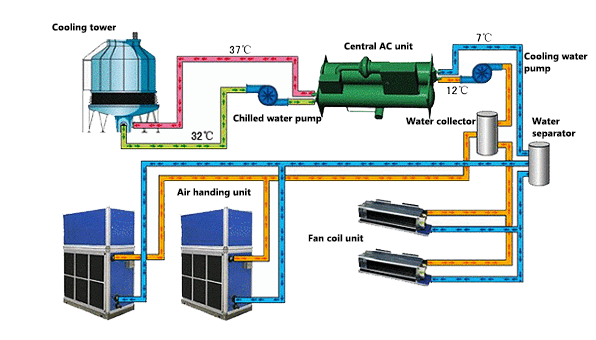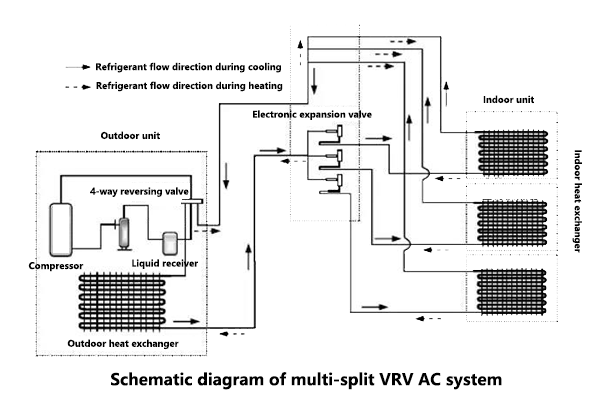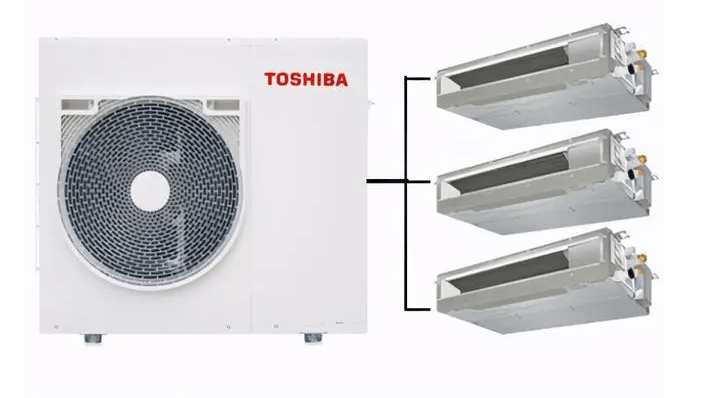
Figure 1: Central AC system.
Decoration is an extremely exhausting task. From planning to completion of the decoration, the trouble and trivialities of the whole process make people not want to go through it again, and even just a certain procedure in the decoration process will make people scream and have a headache.
For example, when you choose a central air conditioner for your house, you need to go to the building materials market, specialty stores, etc. to inquire about central air conditioner merchants. You will hear different opinions from sellers of different brands, and one product recommended by one seller may be immediately denied by another seller.
With so many dazzling central air-conditioning brands, which one should you choose?Who is More Powerful?
An objective fact is that, as far as fluorine system central air conditioners are concerned, Japanese brands are a better choice at this stage, so in this article we will talk about Japanese central air conditioner brands such as Mitsubishi Electric, Daikin, Hitachi, and Toshiba.
1. Development History of Japanese Central Air-Conditioning
In the 1980s, Japan invented its own unique fluorine system air conditioner known for its standardization and energy saving, and occupied a lot of market share. From window-type air conditioners to fixed-frequency wall-mounted units, and then to variable-frequency wall-mounted units, its market share has suddenly expanded to 60%.
Such a high market share has provided Japan with a large amount of capital and technology accumulation. In the 1990s, Japan's VRV technology also began to flourish in the market and was applied to central air conditioning.
Although the United States was exposed to air-conditioning half a century earlier than Japan, Japan came from behind. Japan is almost crazy about the technological update of central air-conditioning. Even if they have reached the top of the industry, they don't slow down the pace of technological innovation. So up to now, Japanese air conditioners still have an unshakable position in air conditioning technology.
After talking about the history, we can talk about the brand itself. The four major brands of Mitsubishi Electric, Daikin, Hitachi, and Toshiba are the Japanese brands with a relatively high market share.

Figure 2: A central AC in a room.
2. Daikin Central Air Conditioner
Daikin was founded in Osaka, Japan in 1924. Daikin focuses on the research and development of air-conditioning systems. In 1951, the earliest commercial cabinet air conditioner in Japan was born in Daikin, and the history of Japanese commercial air-conditioning began.
In 1969, it successfully developed the first home central air conditioner (a multi-split air-conditioning system in which one outdoor unit connected to multiple indoor units).
In 1982, Japan's first VRV intelligent central air-conditioning system (hereinafter referred to as VRV) was born in Daikin, creating a new era of multi-split air-conditioning system for buildings.
Back then, Daikin took the lead in the market by relying on the VRV system. High technical content and low noise became the selling points of its air-conditioning products. For Daikin central air conditioners, the suggestion is to buy high-end models if you have enough budget.

Figure 3: Schematic diagram of multi-split VRV AC system.
2.1 Advantages of Daikin Central Air Conditioner
Daikin VRV air conditioning system has the following advantages:
1) The VRV air-conditioning system has obvious energy-saving and comfortable effects. The system operates continuously at different speeds according to the indoor load, reducing the energy loss caused by the frequent start and stop of the compressor.
2) The compressor is started at a low frequency to reduce the starting current. It will greatly save energy, and at the same time avoid the impact on other electrical equipment and the power grid.
3)The VRV air conditioning system has the advantages of convenient design and installation, flexible layout, small building space, convenient use, high reliability, low operating cost, and no water system.
3. Toshiba Central Air Conditioner
Toshiba Group was founded in 1875, and Toshiba invented the world's first inverter air conditioner in 1980. Toshiba developed the first R410A refrigerant air conditioner in Japan in 1998. Toshiba's leading air-conditioning system technology ensures that it has zero ozone depletion coefficient and is more efficient and energy-saving.
In 2004, Toshiba launched an epoch-making variable-frequency multi-split system: SMMS. It is industry-leading in terms of energy saving, reliability, and quietness. In 2010, Toshiba launched a new generation of fully variable frequency multi-split system: SMMSi. Its excellent technology and reliability made a further leap forward.
Toshiba has a complete series of household central air-conditioning products. According to different room types and decoration requirements, Toshiba has different products to correspond with. Toshiba compressors are stable in performance, quiet and energy-saving, and their twin rotary compressors are very suitable for home decoration.

Figure 4: Toshiba central air conditioner.
3.1 Advantages of Toshiba Central Air Conditioner
Toshiba central air conditioners have the following advantages:
1) The aesthetics is quite high. The indoor unit of Toshiba home central air conditioner is concealed in the ceiling, which avoids being placed like a cabinet unit to occupy indoor space, and brings more freedom to the placement of other furniture. It can be well integrated with the home decoration style and improve the effect and grade of home decoration.
2) Low noise. Toshiba central air conditioner's unique night-time silent mode operation keeps you away from noise pollution. The lowest noise of the Toshiba central air-conditioning indoor unit is only 26 decibels, which ensures that you can have a good dream at night.
3) High comfort. Every Toshiba central air conditioner is carefully calculated by the designer before installation. In the home central air conditioner, each indoor unit has an air supply port and a return air port, and the air circulation is more reasonable.
4) Toshiba central air-conditioning temperature control is accurate to 0.5 degrees Celsius (other central air conditioners usually are ±0.5 degrees, which is a range value), and its temperature control makes the indoor temperature more uniform, and the human body feels more natural and comfortable.
It should be noted that Toshiba's internal unit does not have a condensate lift pump as standard, so it must be measured and calculated before decoration. Another point is that Toshiba's products are relatively weak in terms of energy saving, and if you have energy-saving requirements, choose carefully.
4. Mitsubishi Electric Central Air Conditioner
Founded in 1921, Mitsubishi Electric is a well-known manufacturer in the air-conditioning industry, with profound knowledge in high-tech fields such as compressors, automation, frequency conversion control, and power equipment. Mitsubishi Electric is also actively integrating advanced technology into air-conditioning products. Even in the fiercely competitive Japanese market, its market share has remained among the top three for many years.
Mitsubishi Electric has always invested a lot of effort in the research and development of compressors, and integrated advanced materials, exquisite mechanical structures and high-precision manufacturing processes into it. When Daikin was still struggling with low-pressure type scroll technology, Mitsubishi Electric's low-voltage type scroll compressor had already been mass-produced and applied, demonstrating its strong technical strength.
The reason why Mitsubishi Electric's central air conditioner runs smoothly and has powerful cooling is that in addition to the low-pressure type scroll technology, the "Poki-Poki motor" is also a major contributor. This patented technology that Mitsubishi Electric is proud of is not only standard on split air conditioners, but also central air conditioners.
Poki-Poki motor realizes the compactness of the winding and the reduction of the volume of the motor, which makes the internal structure of the compressor more compact, and effectively improves the stability and operation performance of the compressor. In the European, American and Japanese markets, there are many Mitsubishi Electric central air conditioners that have been used for more than 10 years, and they are still in good operation.

Figure 5: Mitsubishi Electric Poki-Poki motor.
4.1 Advantages of Mitsubishi Central Air Conditioner
Mitsubishi Electric central air conditioners have the following advantages:
1) Low cost of use. Mitsubishi central air-conditioning adopts DC frequency conversion technology and new refrigerant technology. Each indoor unit can be controlled independently. Which room needs cooling, and just turn on the indoor unit in that room, and the outdoor unit "outputs on demand" with low power consumption.
2) High comfort. Mitsubishi central air conditioners can maintain a constant temperature of ±1°C, and the human body feels more natural and comfortable, especially the water system central air conditioners, which are very comfortable.
3) Long life. Usually home split air conditioners (wall-mounted and cabinet units) have a service life of 5-8 years, while home central air conditioners have a service life of 15-20 years. Among them, the service life of Mitsubishi central air conditioning is 25 years, and if it is a geothermal heat pump central air conditioning system, the service life of the system is 50 years.
5. Hitachi Central Air Conditioner
Founded in Tokyo, Japan in 1910, Hitachi invented the first motor in Japanese history that year. In 1983, Hitachi invented and patented the world's first scroll compressor for air conditioners.
In 2003, Hitachi launched a new high back pressure scroll compressor with internal oil separation function for the first time in the industry. Hitachi is a Fortune 500 company in the world. The early Hitachi central air conditioners mainly focused on commercial building projects, and their background strength is still acceptable.
After 2012, Hitachi began to focus on the home decoration market. The internal units of Hitachi central air conditioners are all equipped with lift pumps, which is very good for raising the ceiling height, saving 2 to 3 centimeters, and has great advantages in terms of quietness and energy saving. The operating noise of the internal unit is 21 decibels, which is still at the leading level in the industry.
In actual decoration cases, Hitachi's thin, light and compact internal units are also very competitive, making the ceiling more beautiful and atmospheric.
For Hitachi central air conditioners, because of the rich models, such as VAM mini series, UX inverter series, etc., it is necessary to choose the appropriate model according to your own situation in order to maximize the cost performance.

Figure 6: HITACHI multi-split central air conditioner.
6. Central AC Compressor Types of Daikin, Hitachi, Toshiba, and Mitsubishi Electric
The types of home air-conditioning compressors are mainly divided into scroll compressors and rotary compressors.
The scroll compressor was invented by Copeland in 1905. Hitachi was the first to apply it to household fluorine air conditioners, which was first launched in 1983. Scroll technology is subdivided into three types: high-pressure type scroll, low-pressure type scroll, high-low pressure type scroll (or high-medium pressure type scroll).
The high-pressure chamber scroll type is represented by Hitachi, the low-pressure chamber scroll type by Copeland and Mitsubishi Electric, and the high-low pressure chamber scroll type by Daikin.
The rotary compressor (rolling piston compressor) was invented by Toshiba in 1967. It was originally a single rotary compressor, and now it is basically a twin rotary compressor. Later, a triple rotary compressor was introduced, and the performance of a single compressor reached a maximum of 24 horses.
In one fell swoop, it breaks the view that "rotary compressors cannot achieve high power" that has been complained by other Japanese brands, and surpasses the maximum horsepower of other Japanese scroll compressors. So Toshiba is a thriving benchmark in the field of rotary compressors.

Figure 7: Mitsubishi scroll compressor.
●Toshiba air conditioners use twin and triple rotary compressors, no scroll types.
●Hitachi air conditioners have two types of compressors: twin rotary compressors and high-pressure chamber scroll compressors.
●Mitsubishi Electric air conditioners have three types of compressors: twin rotary compressor, high-pressure chamber scroll type, and low-pressure chamber scroll type.
●Daikin air conditioners have two types of compressors: swing compressors and scroll compressors with high and low pressure chambers.
The swing type is slightly modified on the basis of the single rotary compressor, and is generally included in the rotary compressor type. The high and low pressure chamber scroll compressors combine the high pressure chamber and the low pressure chamber.
Finally, let’s have a simple and intuitive understanding of the types of compressors used in these four brands through a picture:
|
Brands |
Compressor types |
|
Swing compressors, scroll compressors with high and low pressure chambers. |
|
|
Twin rotary compressors, high-pressure chamber scroll compressors |
|
|
Twin rotary compressors, triple rotary compressors |
|
|
Twin rotary compressor, high-pressure chamber scroll compressors, low-pressure chamber scroll compressors |
Table 1: Different types of compressors used in Daikin, Hitachi, Toshiba, Mitsubishi Electric.
7. Conclusion
For friends who want to install central air-conditioning, it is recommended to plan according to their own budget and choose the appropriate brand and model according to their room type. In addition, they must find a reliable brand and installation team. After all, in the central air-conditioning industry, It has always been a wise saying that three points depend on equipment and seven points depend on installation.
Related Info
5 Types of Compressors for Central AC (Working Principles, Pros and Cons)13 Reasons Why Your Samsung Refrigerator Not Cooling (The Latest Version)
How Refrigerator Compressor Works (Structure Diagram, Working Principle Diagram)
How to Change Air Compressor Oil (5 Steps)
What are the 4 Main Components in a Central AC System


